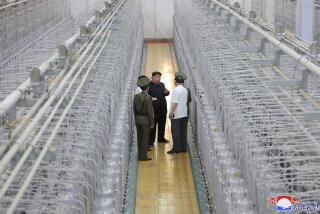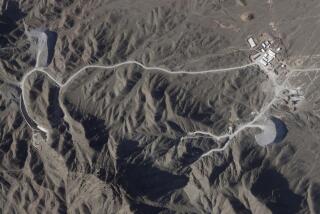U.S. Hints It Would Bomb Libyan Weapons Facility
- Share via
WASHINGTON — The Clinton administration stepped up its threat against a suspected Libyan chemical weapons plant Thursday, publishing an artist’s rendition of the underground facility and asserting that America has the high-tech weapons needed to destroy it.
At a Pentagon briefing, Defense Secretary William J. Perry all but encouraged reporters to take his warning last week--that the United States would not permit Libya to complete construction of the facility--as an outright threat to bomb the plant if necessary.
“You know the announcement and the statement that I have made on that,” Perry said. “If you want to consider that a warning to Libya, you can so consider it.”
Washington charges that a plant being built inside a mountain at Tarhunah, 40 miles southeast of the Libyan capital of Tripoli, is a chemical weapons facility.
As Perry made his thinly veiled threat, other U.S. officials dismissed suggestions by some experts that the United States does not yet have the ground-penetrating munitions to wipe out the plant. They cited the GBU-28, a 5,000-pound laser-guided bomb developed during the Persian Gulf War, as one possibility. The weapon can penetrate through more than 100 feet of earth or 22 feet of hardened concrete, they said--presumably enough to knock out or destroy the Libyan facility.
The rhetoric coincided with Libya’s offer to begin talks “without preconditions” about the U.S. charges. Omar Mustafa Muntasser, Libya’s foreign minister, dismissed the allegations Thursday as “another lie by U.S. intelligence.” But he said that Libya is willing to discuss the accusations “with any country who will agree to talk to us.”
U.S. officials said later that Perry had not intended to suggest that a U.S. bombing raid on Libya is imminent. They said that the United States would first seek to block construction of the plant through diplomatic measures, pressuring foreign suppliers and technicians.
“There are many ways to attack these capabilities,” Army Lt. Gen. Patrick M. Hughes, director of the Defense Intelligence Agency, told reporters at a briefing. “We don’t merely have to drop a bomb on them.”
Nevertheless, the secretary’s remarks, combined with publication of the artist’s rendition of the plant, which was based on satellite photos, appeared likely to intensify the dispute between Washington and Tripoli.
The drawing of the plant--the first to be released by U.S. authorities--shows a remote, desert hillside into which terraces have been cut, with a series of low-level buildings nearby and three tunnel entrances at the base of the hill.
Accompanying text said that building the facility underground “masks its activities and increases its survivability in case of an attack.”
Pentagon officials said that, if further construction is not blocked, the plant will be completed in about a year and will be capable of producing at least 110 tons of blister and nerve agents over three years--the same as a similar plant at Rabta that was shut down several years ago after a fire.
Hughes said that, despite Libya’s denials, the United States has absolutely no doubt that the facility is intended as a chemical weapons plant. He also said that U.S. intelligence agencies have evidence that Libya is receiving equipment or expert help from commercial firms and individuals in several countries. He declined to name them, however, saying that Washington wants to handle the situation privately at first.
The United States issued similar threats of possible military action against the Rabta plant in March 1990, and a few weeks later the facility was struck by an unexplained fire, forcing the Libyans to shut it down.
Ten years ago, U.S. fighter-bombers attacked Tripoli and the Libyan city of Benghazi after Washington said that it had irrefutable evidence linking Libya to the bombing of a Berlin discotheque frequented by American servicemen. Libya said that 37 people died in the raids.
The drawing of the Libyan facility was contained in an 80-page report by the Defense Department on the proliferation of chemical, biological and nuclear weapons by America’s potential adversaries and the steps being taken to bolster U.S. defenses.
The bulk of the other findings had been made public previously. The document said that North Korea has been improving its ballistic missile capability, Iran has sophisticated chemical and biological weapons programs, and China is continuing to market nuclear expertise.
More to Read
Sign up for Essential California
The most important California stories and recommendations in your inbox every morning.
You may occasionally receive promotional content from the Los Angeles Times.












